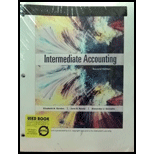
Intermediate Accounting, Student Value Edition (2nd Edition)
2nd Edition
ISBN: 9780134732145
Author: Elizabeth A. Gordon, Jana S. Raedy, Alexander J. Sannella
Publisher: PEARSON
expand_more
expand_more
format_list_bulleted
Concept explainers
Question
Chapter 21, Problem 21.7BE
To determine
To prepare: The
Given information:
Original cost of the asset is $750,000.
Residual value is $50,000.
Estimated life years are 20 years.
The residual value is reduced to $30,000.
Expert Solution & Answer
Want to see the full answer?
Check out a sample textbook solution
Students have asked these similar questions
Kamala Khan has to decide between the following two options:
Take out a student loan of $70,000 and study accounting full time for the next three years. The interest on the loan is 4% per year payable annually. The principle is to be paid in full after ten years.
Study part time and work part time to earn $15,000 per year for the following six years.
Once Kamala graduates, she estimates that she will earn $30,000 for the first three years and $40,000 the next four years. Kamala's banker says the market interest for a ten-year horizon is 6%.
Required
Calculate NPV of the ten-year cash flows of the two options. For simplification assume that all cash flows happen at year-end.
Based on the NPV which of the two options is better for Kamala?
Financial Accounting
Please give me answer with general accounting
Chapter 21 Solutions
Intermediate Accounting, Student Value Edition (2nd Edition)
Ch. 21 - Are accounting changes permitted in financial...Ch. 21 - How do firms report accounting changes under the...Ch. 21 - Prob. 21.3QCh. 21 - How do firms account for changes in accounting...Ch. 21 - Prob. 21.5QCh. 21 - Prob. 21.6QCh. 21 - Prob. 21.7QCh. 21 - Prob. 21.8QCh. 21 - Do accounting errors that self-correct within two...Ch. 21 - Does a firm need to correct an error that...
Ch. 21 - Prob. 21.1MCCh. 21 - Prob. 21.2MCCh. 21 - Prob. 21.3MCCh. 21 - Prob. 21.4MCCh. 21 - Prob. 21.5MCCh. 21 - Prob. 21.1BECh. 21 - Prob. 21.2BECh. 21 - Prob. 21.3BECh. 21 - Prob. 21.4BECh. 21 - Change in Accounting Principle, Long-Term...Ch. 21 - Prob. 21.6BECh. 21 - Prob. 21.7BECh. 21 - Prob. 21.8BECh. 21 - Prob. 21.9BECh. 21 - Prob. 21.10BECh. 21 - Prob. 21.11BECh. 21 - Prob. 21.12BECh. 21 - Prob. 21.13BECh. 21 - Prob. 21.14BECh. 21 - Change in Accounting Principle, Inventory. Massi...Ch. 21 - Change in Accounting Principle, Long-Term...Ch. 21 - Prob. 21.3ECh. 21 - Change in Accounting Principle, Inventory. Winthur...Ch. 21 - Prob. 21.5ECh. 21 - Prob. 21.6ECh. 21 - Error Analysis and Correction. Feinstein and...Ch. 21 - Prob. 21.8ECh. 21 - Prob. 21.9ECh. 21 - Prob. 21.10ECh. 21 - Change in Accounting Principle, Inventory. Second...Ch. 21 - Prob. 21.2PCh. 21 - Prob. 21.3PCh. 21 - Prob. 21.4PCh. 21 - Prob. 21.5PCh. 21 - Change in Estimate, Inventory, Bad Debt Expense....Ch. 21 - Prob. 21.7PCh. 21 - Cases Judgment Case Judgment Case: Materiality and...Ch. 21 - Prob. 1FSCCh. 21 - Surfing the Standards: Change in Accounting...Ch. 21 - Prob. 1BCC
Knowledge Booster
Learn more about
Need a deep-dive on the concept behind this application? Look no further. Learn more about this topic, accounting and related others by exploring similar questions and additional content below.Similar questions
- Kiran Manufacturing produces a product with a standard direct labor cost of 1.8 hours at $18.75 per hour. During August, 2,250 units were produced using 4,150 hours at $17.50 per hour. What is the labor quantity variance (labor efficiency variance)?arrow_forwardI need help with this general accounting question using the proper accounting approach.arrow_forwardPlease explain this financial accounting problem with accurate financial standards.arrow_forward
- Post it in general accounting tutors feed. Please answer me fast.arrow_forwardDiscuss the accounting treatment for property and equipment impairment and the potential impact on the company's financial statements. What factors can trigger an impairment test? Helparrow_forwardLoki company purchases inventory on credit for $40,000. Inventory costing $30,000 is sold on credit for $50,000. The applicable HST rate is 10%. Sales taxes are remitted on a monthly basis. Required Prepare the necessary journal entries for Loki company regarding: Purchase of inventory Sale of goods Remittance of sales taxarrow_forward
- What is lumas net income using cash basis accounting ?arrow_forwardGeneral Accounting Questionarrow_forwardAnticipated unit sales are January, 5,000, February, 4,000, and March 8,000 Finished goods are consistently maintained at 80% of the following month's sales If units cost $10 each to produce, how much is February's total cost of production? Helparrow_forward
arrow_back_ios
SEE MORE QUESTIONS
arrow_forward_ios
Recommended textbooks for you
 Intermediate Accounting: Reporting And AnalysisAccountingISBN:9781337788281Author:James M. Wahlen, Jefferson P. Jones, Donald PagachPublisher:Cengage LearningPrinciples of Accounting Volume 1AccountingISBN:9781947172685Author:OpenStaxPublisher:OpenStax College
Intermediate Accounting: Reporting And AnalysisAccountingISBN:9781337788281Author:James M. Wahlen, Jefferson P. Jones, Donald PagachPublisher:Cengage LearningPrinciples of Accounting Volume 1AccountingISBN:9781947172685Author:OpenStaxPublisher:OpenStax College College Accounting, Chapters 1-27AccountingISBN:9781337794756Author:HEINTZ, James A.Publisher:Cengage Learning,
College Accounting, Chapters 1-27AccountingISBN:9781337794756Author:HEINTZ, James A.Publisher:Cengage Learning, Cornerstones of Financial AccountingAccountingISBN:9781337690881Author:Jay Rich, Jeff JonesPublisher:Cengage Learning
Cornerstones of Financial AccountingAccountingISBN:9781337690881Author:Jay Rich, Jeff JonesPublisher:Cengage Learning

Intermediate Accounting: Reporting And Analysis
Accounting
ISBN:9781337788281
Author:James M. Wahlen, Jefferson P. Jones, Donald Pagach
Publisher:Cengage Learning

Principles of Accounting Volume 1
Accounting
ISBN:9781947172685
Author:OpenStax
Publisher:OpenStax College

College Accounting, Chapters 1-27
Accounting
ISBN:9781337794756
Author:HEINTZ, James A.
Publisher:Cengage Learning,

Cornerstones of Financial Accounting
Accounting
ISBN:9781337690881
Author:Jay Rich, Jeff Jones
Publisher:Cengage Learning
Accounting for Derivatives_1.mp4; Author: DVRamanaXIMB;https://www.youtube.com/watch?v=kZky1jIiCN0;License: Standard Youtube License
Depreciation|(Concept and Methods); Author: easyCBSE commerce lectures;https://www.youtube.com/watch?v=w4lScJke6CA;License: Standard YouTube License, CC-BY